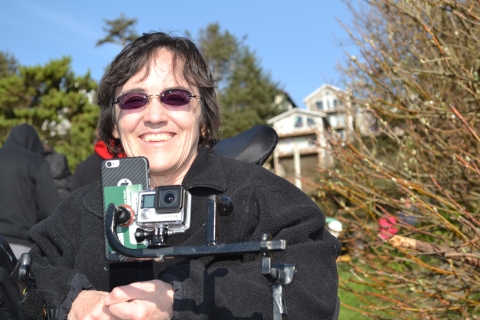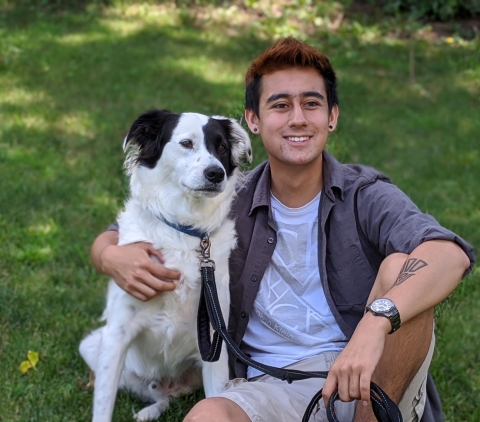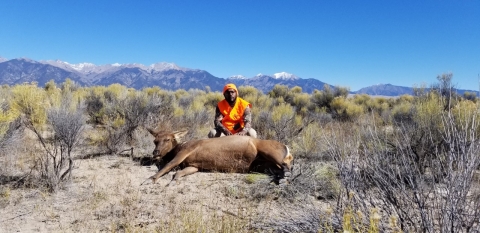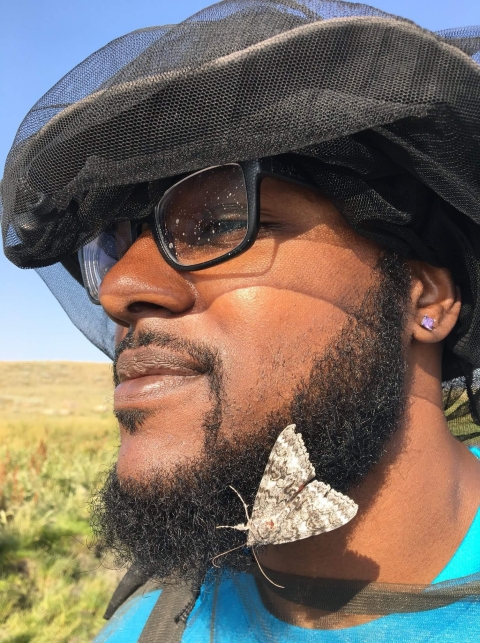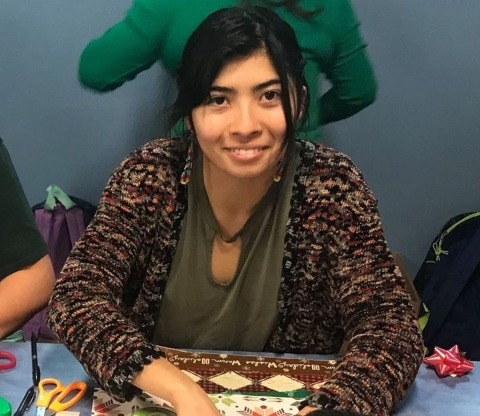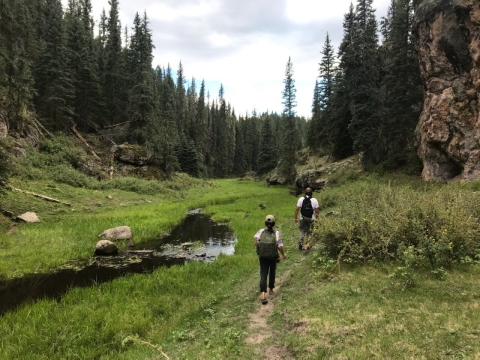Do you feel at home in nature? What does belonging in nature look like for you?
Those may sound like odd questions, but access to green space and outdoor experience vary widely, depending on where you live, your economic status, your race, culture, health or family background.
Connecting people to nature is a priority for the 101 urban national wildlife refuges and more than 30 U.S. Fish and Wildlife Service partnerships in cities across the country. The message is not just: Come visit. It’s also: We’re listening. What do you value in nature? What makes you feel welcome? What have been your experiences?
Why? Because there is no one way to experience nature. Because ensuring access to nature benefits everyone even as it grows the ranks of tomorrow’s conservation stewards.
To spark a broader conversation about inclusion in the outdoors, we asked five people to share their thoughts and stories.
Five Perspectives
Jeannette Guess,
former vice president of the Friends of Heinz Refuge in Philadelphia
Georgena Moran,
disability rights activist in Portland, Oregon
Oscar Hernandez,
Latinx family liaison for Minnesota Valley National Wildlife Refuge
Dwane Binns,
manager, San Diego National Wildlife Refuge
Julietta Conzuelo,
former intern at Valle de Oro National Wildlife Refuge in New Mexico
"They never told me I could go here"
Jeannette Guess, the affable former vice president of the Friends of Heinz Refuge in Philadelphia, is, by her own account, a nature lover, a people person and a community activist. The community is Eastwick, a predominantly African American neighborhood that is also the gateway to John Heinz National Wildlife Refuge at Tinicum. “You can’t get to the visitor center without going through Eastwick,” says Guess.
Which is why she finds it ironic that the refuge and the community had so little interaction until recently. “When I moved to Eastwick in 2006, I saw signs for John Heinz National Wildlife Refuge. I asked my neighbor, ‘What is that?’ My neighbor said, ‘Oh don’t go in there. There’s wild animals in there. You don’t want to go in there.”
She went anyway — “I’m a retired police officer, so I’m not afraid” — and soon became an enthusiast and volunteer.
“I never knew how grateful I would be to be able to walk into a place like Heinz Refuge. It’s my place of tranquility. Being by the creek, hearing the birds chirping and the frogs, I never experienced that before and it really brought calm to me. It’s an amazing experience.”
She regrets not having known about it sooner. “Growing up in a predominantly black North Philly neighborhood and going to the public school system, they never told us we could visit Heinz Refuge. The refuge never reached out to the public school system to say that black schools were invited. We didn’t know anything about it.”
Also missing, she says, was “the educational piece to tell people that there’s nothing there that’s going to harm you. … if you don’t know that [there’s nothing to fear from the wildlife at this refuge], why would you go there? It wasn’t welcoming. It really wasn’t.”
She’s proud the refuge has worked to change its image in the community.
”Now more people of color come to the refuge. The refuge has also established community gardens. That’s a big plus. They have community meetings at the refuge. And programs in the schools. So now people know, ‘Yes, you are welcoming us.’ That’s a good thing because there’s so many people that want to know more about nature.
“You’ve got to get the kids while they’re young. Tell them it’s okay to be part of nature. It’s okay to go fishing at the refuge. It’s okay to hike in the refuge and come take pictures and use your binoculars and be part of programs at the refuge. You can tell them, ‘Bring your parents. Bring your aunties and uncles. Let them know they can come to the refuge.
“When I went to the refuge for the first time, I didn’t encounter any employees or volunteers who looked like me. That was quite intimidating.
“I have brown-skinned children, and I want them to see other kids that look like them. I want there to be a variety of children from all types of cultures. That wasn’t the case when I first got here, but slowly it’s truly changed.”
"Easy access is critical – especially now"
Georgena Moran defines herself by what she can do, not what she can’t. “I’m an adventurer, an avid outdoor explorer,” she says. She’s also the founder of Access Recreation, a Portland, Oregon-based organization that promotes outdoor access for people with disabilities. People like herself. Because her limbs are paralyzed, she navigates trails using a power chair she drives with her chin.
“I want to be in nature more than anything especially these days, with the Covid-19 factor and people restricted at home, especially people with disabilities.”
“I hike. I go out there. My interest isn’t a paved trail. I like things that show nature in its fullness, like natural surface trails. I like going places I’ve never been. My greatest obstacle is getting information [on whether I can use a trail with a wheelchair.]”
Moran often hikes with her wife, Sharon Mitchell, or her mother-in-law, Anna McClinton. Two of her favorite destinations are Tualatin River National Wildlife Refuge outside Portland and Steigerwald Lake National Wildlife Refuge outside nearby Vancouver, Washington.
“Tualatin River Refuge was the first refuge I visited. What I loved about it was they had wildlife blinds that were accessible. But they didn’t say that on their website. I wouldn’t have known that if I hadn’t gone on a tour.”
What she asks is that land managers put more information on their websites so she can decide what’s do-able.
“They’ll talk about cool things that would entice me to see the beauty, but one thing they don’t talk about is the surface of a hiking trail. Don’t assume I just want a paved trail. Show me some of the things I might be interested in: the grade, the cross-slope. Are there benches along the trail? Is there an accessible restroom? And what does ‘accessible restroom’ mean? Because me, I can’t use a stall. Does a picnic area have an accessible picnic bench?
“I absolutely belong in nature. Nature is where I feel like I can be at my best … But I don’t want to drive a great distance and be frustrated for some obscure reason, you know, like a culvert at the head of a trail that I can't traverse.
Living with a disability, says Moran, “demands you be creative. … Recently I designed a fisherman’s float that I was lifted into. I put two motors on it that I could manipulate with a chin drive. I was able to go out into ocean, play with my friends with all their little floats.”
Access Recreation has reviewed 36 trails and parks in the greater Portland-Vancouver region.
It’s had some success, says Moran, despite technology delays. In many cases, fixes are relatively cheap and quick.
Often, she says, “once agency staff got our input, they could immediately address some of the issues.” Many involved “transitions — say, going from a natural surface to a wooden bridge. All it would take is a little maintenance. A lot of times, they would come out that same day and fix it. They just weren't aware that a two-inch transition was an issue. Or maybe they haven’t been out there for a while to know that it was necessary.”
You don’t have to hire her group to evaluate your website’s trail descriptions, she says. “You can do it yourself. Just add more pictures with a description. That would be a tremendous help so people can decide if a trail meets their needs before they go.”
"Getting out with others like me is more welcoming"
As a first-generation Mexican-American growing up in the suburbs of Minneapolis, Oscar Hernandez lacked the privileges of some of his classmates. “They would talk about visiting the cabin for the weekend or going on vacation to these beaches in Miami or going to Buck Hill to snowboard for the day. I didn’t have any of that.”
He learned to love nature anyhow. Now, as Latinx family liaison for Minnesota Valley National Wildlife Refuge, he wants to help others love it, too.
“As a kid growing up, my dad would take me fishing sometimes. I remember going out with my little blue kiddy fishing rod, fishing for bluegill. I don’t remember catching very many fish, but I think the idea of fishing for a live animal — that was really exciting for me.”
Hernandez’s first visit to a national wildlife refuge national wildlife refuge
A national wildlife refuge is typically a contiguous area of land and water managed by the U.S. Fish and Wildlife Service for the conservation and, where appropriate, restoration of fish, wildlife and plant resources and their habitats for the benefit of present and future generations of Americans.
Learn more about national wildlife refuge was in May 2018 — when he began his internship at Minnesota Valley Refuge. What he saw astonished him.
“I couldn’t believe there was this giant area for people to enjoy outdoors and it was free. And it was so close to where I live — closer than the Mall of America, and I went to the Mall of America all the time. I would catch the bus there, hang out there with friends. I never knew the refuge was minutes from there. I thought that was a real shame, because if I didn’t know, I figured other people didn’t know either.
“I honestly fell in love with the place. It has so much to offer. There's such a wide variety of habitats. I just thought it was it was amazing to see that, and to have that in a city.”
Hernandez says he had outdoor experiences growing up. “They just weren't the traditional experiences that others may have had … I never went kayaking. I went on a canoe once. I've been camping a few times, but not as much as other people.
“I think that not seeing us do these traditional experiences like hiking or kayaking has led to the misconception that Latinos don’t care for the outdoors or the environment. That couldn’t be farther from the truth. We are out here going to the lake in the summer for our carne asada [cookout] with our families. We are out here throwing little kids’ birthday parties at the park. We are out here experiencing nature in a different way than what is traditionally thought of as going outdoors.”
These days, he generally shares his nature outings with his dog, Pirata, or friends.
“Usually when I go outside, I feel more comfortable in a group of people who understand me, because I don’t have the most experience in nature. When I go out with strangers, they can recognize bird calls or animal prints in the mud. I can’t do that. I’m learning. But getting out in a group with other people who speak like me, it’s more welcoming.”
He doesn’t mean to speak for others, though.
“Latinos come from so many different countries, and they’re in so many different parts of the United States that each community can be really different. So, I have some thoughts that others may not necessarily agree with. Just because I have my own experience, it doesn't mean that I’m representative of every Latino in the U.S. or even Minnesota.”
"We need to consider how others engage with nature"
Dwane Binns, who in March 2020 became manager of San Diego National Wildlife Refuge, straddles two worlds: the big-city world of his roots in Queens, New York, and the more rural world of the avid hunter, camper, angler and nature lover he has become.
A biologist and the son of biracial parents — his father is from Jamaica; his mother from Guyana — he’s a conceptual and analytical thinker, inclined to examine his and others’ behavior for patterns and meaning.
“What I like to do in nature is hunt,” he says. “Hunting is taking part in a historical practice about how we engage with nature, inserting humans back in the food web that we’ve been removed from” by the commercialization of the food system.
One of his favorite destinations is the San Luis Valley in Colorado — including Monte Vista, Alamosa and Baca National Wildlife Refuges. The valley “has abundant opportunities to engage in outdoor recreation in a more historical fashion — by which I mean hunting.”
As an urban black man, he is well aware that he doesn’t fit the stereotype of a hunter and outdoorsman. His outdoor experience came relatively late in life, and much of the outdoor skill he learned, he had to teach himself.
“When I was growing up, there was no real land that a family member had that I could go and experience nature in that was anything remotely representative of what I go to engage with now.” Also missing: a mentor who “will teach you how to go about using the land in a sustainable and efficient and successful fashion.”
“My only experience was a city lifestyle, which a lot of people of color are relegated to. I think that is pretty common across different ethnic and racial backgrounds when you're in the city.”
“I would say 85 percent of the families in New York City, because of their lack of exposure to nature, they don't have the information to engage in it and reap the benefits that a sustainable and nurturing engagement with nature can provide.”
San Diego, he’s finding, “is not very dissimilar from the mindset of New York City, in terms of access to resources.” He envisions being a bridge “to help people understand from a cultural perspective how nature can enrich their lives … They don’t understand what they are missing. They don’t have anybody that engages with them, even though the refuge is just 30 minutes outside of the city.”
For Binns, nature is not just a place to recreate; it’s also a retreat.
Sometimes, he says, “I try to go to more secluded areas where I can just sit down and be a presence within a forest — just to observe how life around me is interacting with other life in a natural landscape. And kind of getting back to the roots of … if we didn't have all this development, what would nature provide for us?”
He’d like to see conservationists expand their ideas about how people engage with nature.
“We have very much hung our hat on a North-American-centric view of engagement with natural resources. We're trained to say there's a certain way we engage with nature — like going into nature only to hike or fish. I think we need to reevaluate and consider the ways that other cultures engage with nature. Some cultures use natural spaces to congregate or as sort of a fellowship area.” What’s wrong with that? Binns asks.
“We need to ask: How do we become more inclusive? How do we get other Dwanes to be aware that the refuge is a welcoming place? That the refuge has so many tangible and intangible benefits that in a city lifestyle you may not even know you may be missing?”
"We’ve gone away from being in nature"
After graduating high school in 2015 and enrolling in community college, Julietta Conzuelo was committed to “just working to get money to have a chance of buying a house, owning a nice car and everything.” A job in a casino cured her of that. She found the hours brutal, the food waste disturbing.
“I hated being in the casino, seeing so many people gamble their money away. It's very disheartening. I just wanted to be outside.”
She quit and signed on with the Texas Conservation Corps, learning about the Gulf of Mexico ecosystem and planting cordgrass to slow erosion. Next stop: the Albuquerque Rocky Mountain Youth Corps, where she joined a fire crew. And then she became an intern with Valle de Oro National Wildlife Refuge and Sandia Mountain Natural History Center near Albuquerque.
Conzuelo grew up in Albuquerque. Her Mexican-American heritage — her father’s family comes from central Mexico; her mother is from Albuquerque – colors her views about the environment.
“With my culture, I feel that everything that we exploit from the land has a consequence … because we're a part of this bigger ecosystem. We're an embodiment of this Earth. So when people throw trash or a cigarette butt outside, we're also inflicting that pain within ourselves.
“I feel like we're all a part of nature. But with our way of life — the fast life of making enough money to support a family, and [the emphasis on] technology, I see how, as a society, we've gone away from being in nature. We feel like we don't have enough time.”
As a child, she says, she had few traditional outdoor experiences. “Both of my parents were working. They would leave us with our grandparents, and they would take us to the park and then to the river. Because the river passes through the whole city. It's a big part of New Mexico.”
Valle de Oro National Wildlife Refuge did not wow her at first.
“Visiting it for the first time. I was like, Oh, this is a lot of grassy flat land, and it's very dry. And there was only one tree … Honestly, when I first saw it, I thought it was pretty dull.”
Slowly, her view changed. She learned the refuge, a former dairy farm, was established only in 2012 and was working closely with the adjacent Mountain View community to chart its future. “Because Mountain View has no green space. It's very industrial, and so the community wanted a green space and a place to recreate and bring their families.”
“Once you learn the story and meet the people, it's amazing. For me, Valle de Oro Refuge is a very, very special place, even though it may not look like it at first. I've also learned a lot about birds through being at the refuge — all the cranes and the cattle egrets and the meadowlarks. I never knew these names of birds before. Experiencing the refuge has changed my whole perspective. I never knew this existed in my hometown. I just never knew.”
She likes to reach out to others who are still in the dark.
“As an intern, I led field trips into the mountains for some students of color. Just like me when I was younger, they’d never been to the mountains. I got to speak with them in their native tongue. It was awesome.
“The students talked about how they didn't have a lot of time, how they’d never seen a squirrel before … or the different types of trees you see when you get to higher elevations. Because at the low levels, you see cactuses, some junipers. And then when you go higher, you see ponderosa pines and aspen trees. That was very new for them.
“[They appreciated] sharing their experience with another person that they felt comfortable with. Not just another educator that's strict and wants you just to sit down and write.”
Conzuelo loves spending her off-hours at the refuge. “I go really early in the morning, and I like to bird. I like to hike with friends and family, learn about the plants, the bugs, the ecosystem, everything. Just like a little kid.”



